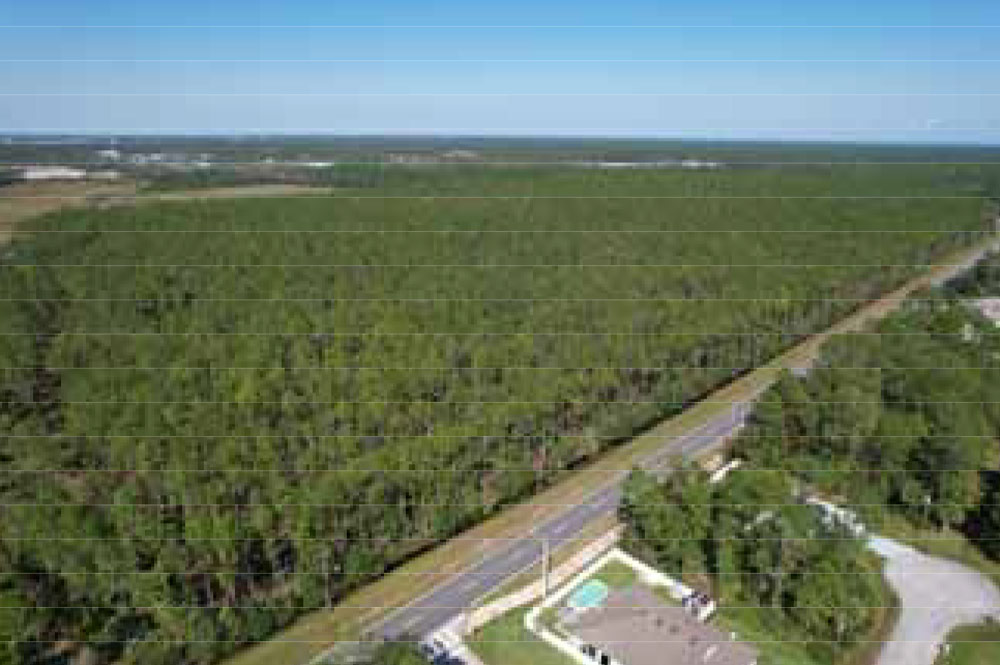
It’s not on Tuesday’s agenda of the the Palm Coast City Council meeting. But the council is almost certain to discuss, for the first time, the threat of a lawsuit by the developer of Cascades, a 375-acre planned development at the south end of Seminole Woods Boulevard.
The council in November 2023 approved the development, but more than halved the developer’s requested density. Douglas Property and Development operating through a subsidiary called Byrndog PCP, sought to build 416 single-family homes and 434 apartment units for a total of 850 housing units. The council approved only the 416 single-family houses, killing the apartments. It did so weeks after the council had approved on first reading a land use change hat would–and in the developer’s view should–have cleared the way for all 850 housing units.
Public opposition from Seminole Woods neighborhood built quickly and pressured the council to reject the rezoning. Faced with opposition from about 18 people who addressed it, often in bitter terms, and occasional through dog whistles critical of apartments (some residents claimed without evidence that apartment buildings would loom over their properties and violate their privacy), the council did so on second reading of the ordinance, and affirmed the vote at a subsequent re-hearing requested by the developer.
The developer had no reason to expect the reversal, though it’s notable that when it came time to vote, then-Council member Ed Danko asked Michael Chiumento, the land-use attorney representing Byrndog, if the developer was willing to drop the apartment request and stick with the single-family homes. In a sense, Chiumento agreed, with a door left open for the future: “So I guess what would make sense to me is to agree and to amend the zoning application to just place single family residential on the entire property,” Chiumento said. “And then we would come back and deal with phases into the future.”
Residents who had just lambasted the developer and the council now cheered them, and the 3-1 vote went through. The council thought the matter settled.
Exactly a year later, Byrndog sent a claim letter to the city under the state law, commonly known as the Bert-Harris Act, that gives property owners the right to claim monetary damages if they can prove that a government action–like a rezoning–infringed their development rights. The next step would be a lawsuit. But under the law a claim letter must come first. It must also give the target agency 90 days to respond.
Byrndog is making a claim for $12.2 million. The sum is based on an appraiser’s evaluation of the prospective revenue lost by eliminating the apartments from the equation.
Only one council member who was part of the 2023 vote is still on the council: Theresa Pontieri. Pontieri had led the opposition to the higher density, and remains committed to the 2023 vote. She has spoken in the past about the city needing to make land-use policy based on its own interpretations of the public interest rather than from fear of litigation. But public interest in this case can be interpreted very differently: the city remains in desperate need of apartment units, and higher densities by way of apartment buildings reduces sprawl, which single-family homes generate.
On the other hand, public opposition to development has been intensifying for several years. The reason only one council member remains from 2023 is that the others, all of them more favorably disposed toward development, have either resigned or been defeated in further electoral bids, while a man who built a campaign on an anti-developmen theme–Mike Norris–was elected mayor.
Other than Pontieri, none of the current council members would have been intimately familiar with the Cascades issue other than through news reports. It isn’t clear why they have not discussed the matter in December or January, so they wouldn’t be under the gun Tuesday to decide how to proceed. Since the Byrndog letter isn’t yet litigation, the council could not hold a legal “shade” or closed-door meeting to discuss it. A city spokesperson said today there’d been no direction that the item be placed on an agenda, “but it’s very likely it will come up” at Tuesday’s meeting. Any of the council members or the city attorney may bring it up, though the litigation is being handled by Anthony Garganese, an attorney in the law firm that formerly represented Palm Coast (it is most familiar with the development.)
In the last two weeks, Acting City Manager Lauren Johnston sent all the Cascades background material to each council member. Each member has met individually with her and Garganese. But the attorney and Johnston could not legally transmit anything one council member said to another in those meetings. They may only discuss it in an open meeting. The council could request that the rezoning matter be reopened. It could reverse its decision or amend it. Or it could decide to fight the litigation: Bert-Harris lawsuits are not easy to win even in a state very friendly to property rights, and are sometimes filed as a tactical move in hopes of winning some concessions, as neither side is eager to end up in court.
So far Byrndog’s positon has been made clear through its claim letter. But the council’s direction will become clear only on Tuesday. Byrndog is playing up what it interprets are assurances by the city administration, ratified in that first-reading vote, that it would get its desired 850 units. But administrative commitments have no weight against a council’s final vote, even if that vote is a reversal. One of the outcomes from the Bert-Harris claim could be yet another reversal, but the make-up of this council makes that unlikely.
“It must be noted that even the 850 dwelling unit cap was not the highest and best use of the Property to which Byrndog was entitled upon being annexed into the City in 2023,” the claim letter notes. “Byrndog consented to this cap at the direction and recommendation of the City itself, as part of the negotiations by which Byrndog agreed to be annexed. In reasonable reliance on the assurances and representations of the City that no limit lower than 850 dwelling units would be imposed, Byrndog (a) agreed to be voluntarily annexed into the City; (b) consented to this limit, which is not the highest and best use of the Property; and (c) expended a considerable sum on pursuing both annexation and the plans for development of the Property.”
![]()




























Dennis C Rathsam says
From what Ive read & seen…. Every builder of these outrageous mini cities, desrtroying nature, life in Palm Coast are always represented by CHIUMENTO. Palm Coast cant handle all this traffic! Our main streets are not wide enough, our side streets are worse! Why is 1 lawyer able to screw the city time & time again. He rakes in all the money, & laughs as are city is rots on the vine! Theres not one person in Palm Coast thats happy with all this build up, traffic, & congestion. youre killing the city, we call home. Shit, we dont even have a police dept…..New mayor, some new council changes, BUT the song remains the same!!!!! Its a broken record now, our leaders need hearing aids.How many times do we have to beg to stop this insanity.Listen to the people. We pay your salarys. Lets fix the traffic problems, before this whole city turns into a gigantic parking lot! PAY the money.Stop the build
Ross says
We do not want anymore developments!
FLF says
Can you imagine what Palm Coast would look like today, if we actually had growth based on the natural ebb and flow of the market/ finance rates. I bought my lot in 2001 from ITT, built a modest home and watched the growth here at a very modest rate over the last 20 years. You could buy a home and land here for under a $100K. The local area wages supported that level of investment and you were a homeowner living the American dream in a wonderful quiet community that we all learned to appreciate. Now to present day, someone decided we needed mega development, lots of minimum wage jobs, destruction of hundreds of acres of land, SR100, jammed with traffic, strip malls, gas stations, for what? Who is going to live in these new developments? There is absolutley no wage support to afford these houses, no infrastructure for water and sewer to support this so I guess it’s going to be retirees buying them on fixed incomes that can’t handle tax increases, insurance costs, utilitiy increases? Why are we doing this? Why do we keep doing the same thing over and over expect a different result? This is not in our best interest as citizens of this city, somebody is getting greased well and our politicians are up for the highest bidder here. Its the only thing that makes sense since no one has the courage in our government to say enough is enough our constituants don’t want this!!! Now the city of Bunnell is faced with an 8000 home debacle waiting in the Haw Creek flood plain, what could possible go wrong?
Atwp says
We will see what happens. The picture is beautiful, how long will it stay that way. What a beautiful sight. As building continues the woods will not be s beautiful.
celia pugliese says
Palm Coast does not have the “water”, sewer plant, roads and services to approve these additional units is enough reason! How come in this city, administrators always talk about the developers entitlements and not about the residents entitlements?
Maybe the developer misconstrues and misinterpret Bert-Harris as : Under the act, a claim exists if a governmental entity inordinately burdens an existing use of real property or a vested right to a specific use of real property.2 “Inordinate Burden
According to the Harris Act, an inordinate burden occurs when a governmental action directly restricts or limits the use of real property such that the owner is unable to attain the reasonable, investment-backed expectation for the existing use or vested right to a specific use”
As such, the court found that the impact of the ordinance was not readily ascertainable until the PROPERTY OWNERS permit applications were denied.
“May a property owner maintain an action pursuant to the Harris Act if that owner has not had a law, regulation, or ordinance directly applied to the owner’s property which restricts or limits the use of the property?”13
Vested Right and Existing Use
Another issue that exists in Harris Act claims are the definitions of “vested right” and “existing use.” While the act defines the terms, it also provides that the circuit court shall determine whether an existing use of the real property or a vested right to a specific use of the real property existed. Thus, it gives some guidance, but recognizes that the determination is made on a case-by-case basis and is in the hands of the courts. According to the act, a vested right is determined by applying principles of equitable estoppel or Florida statutory law. Under the principles of equitable estoppel, a property owner has a vested right if he or she 1) in good faith; 2) upon some act or omission of the government; and 3) has made such a substantial change in position or has incurred such extensive obligations and expenses that it would be highly inequitable and unjust to destroy the right he acquired.27 In Citrus County v. Halls River Dev., Inc. 8 So. 3d 413 (Fla. 5th DCA 2009), the Fifth District reversed the trial court and ruled that there is no vested right to intended use of the property based on equitable estoppel, despite the county’s erroneous advice about the property’s permitted uses, as the doctrine of estoppel does not apply to transactions that are forbidden by law or contrary to public policy.28 The governmental agency would need to reasonably lead the landowner to believe he or she had the right, and that may be difficult to prove. The Fifth District recently ruled in Town of Ponce Inlet v. Pacetta, LLC., 120 So. 3d 27 (Fla. 5th DCA 2013), that there was no equitable estoppel when claimant attempted to develop 16 acres that would require changes to the Comprehensive Land-Use Program, and when there were four years of communications and representations between the planning department, citizens, and its council to approve, but the town did not make the changes.29
An “existing use” is defined by the act as:
An actual, present use or activity on the real property, including periods of inactivity which are normally associated with, or are incidental to, the nature or type of use; or activity or such reasonably foreseeable, non-speculative land uses which are suitable for the subject real property, and compatible with adjacent land uses and which have created an existing fair market value in the property greater than the fair market value of the actual, present use or activity on the real property.
A time-limited permit cannot create a reasonable expectation that the specially permitted use will be allowed to continue indefinitely.30 If government entity and landowner were both mistaken about the use of the property and the use was actually not legal, then there was no existing use.31 The use needs to be one that is reasonably foreseeable and nonspeculative.32
Inordinate Burden
According to the Harris Act, an inordinate burden occurs when a governmental action directly restricts or limits the use of real property such that the owner is unable to attain the reasonable, investment-backed expectation for the existing use or vested right to a specific use; temporary burdens or those impacts caused by governmental action to remediate a public nuisance are not included. The express language of the act indicates that it only applies to as-applied challenges, which brings us back to the above discussion. Until a development plan is submitted, a court cannot determine whether government action has inordinately burdened the property. Thus, a property owner cannot bring a claim until he has applied for a development permit approval and the approval is denied.33 In addition, the act does not apply to government actions dealing with the general police power needs of its citizens, as that would severely limit the willingness of local government to act.34 Lastly, an ordinance could expressly exempt a property, but the exemption does not in and of itself inordinately burden property.35
Remedies
Another aspect of the act is encouragement for the parties to resolve claims by using alternative remedies. During the 150-day notice period, unless extended by agreement of the parties, the government entity must make a written settlement offer that can include adjustment of land development; increase in density, intensity, or use; transfer of developmental rights; land swaps or exchanges; mitigation, including payments in lieu of onsite mitigation; location on the least sensitive portion of the property; conditioning the amount of development or use permitted; etc.38 Any settlement must protect the public interest served by the regulations at issue. As such, if a settlement is reached that contravenes the statute, the parties must file an action for the court to approve the settlement agreement.39
Once a lawsuit is filed, the court is limited to remedy monetary damages only.40 However, the new legislation appears to change that ruling. In Hussey v. Collier County, 2014 WL 5900018 (Fla. 2d DCA 2014), the Second District held that if parties do not settle during the required pre-suit period under the act, the property owner could only bring suit for compensation. At the point of filing a lawsuit after no settlement, the only issue was whether the property owner is entitled to compensation, and, if so, how much. Thus, the remedies available under the act, including transfer of developmental rights and those remedies that would contravene statutes, were only available during the pre-suit period. This limitation is detrimental to both local governments and property owners. Local governments would be forced to use taxpayer funds when other remedies could resolve the matter and landowners may rather have the alternate remedy than monetary compensation.
The 2015 amendment to the act makes a few changes concerning remedies and settlement agreements with the local government entity. Now, it is clarified that settlement agreements pursuant to the act may take place during the 90-day notice period or after the filing of the action in court, as long as the settlement resolves all claims; thus, government entities may avoid or end litigation. Further, the 2015 amendment provides an exception to government action taken to adopt a Flood Insurance Rate Map pursuant to the Federal Emergency Management Agency. While limiting claims pursuant to the act, with said exemption, the 2015 amendment added §70.45, titled “government exactions.” The added section opens entire new causes of action pursuant to the act for “conditions imposed by a governmental entity on a property owner’s proposed use of real property that lacks a nexus to a legitimate public purpose.”41 It will be interesting to see which claims are brought under the new section and how the courts will interpret “legitimate public purpose” along with “conditions imposed by governmental entity.”
Conclusion
The implementation of the Harris Act and the subsequent amendments clearly evidence the Florida Legislature’s desire to recognize landowners’ rights. However, despite the amendments’ clarifications, the courts continue to struggle with the extent to which the protection extends. The courts certainly need some additional clarification from the legislature, and hopefully the new legislation will provide some. Thus far, the judiciary has made rulings to protect both landowners and local government, carrying out the assumed intent of the legislature. While the judicial system has come a long way from Coffield,42 it also has to keep checks and balances so as not to expose local government to massive amounts of claims that would drain taxpayer dollars. Should the Florida Supreme Court agree with the dissent in Smith, it may have this effect among many others.43
JimboXYZ says
Need to rename that entire area Alfinville, FL, rename the road the David Alfin Boondoggle Parkway.
Tina Olive says
It’s too bad that Mayor Norris and the new council members will have to spend the majority of their terms trying to legally undo all the corruption previous Mayor Alfin the previous council members, his cohorts, contractors, and legal council got the city into…Instead of trying to create jobs and make palm coast a very desirable place to live, work and retire, it was more important to line pockets than do what the majorty of taxpayers wanted for their city…I’m sure the previous administrators are watching this cluster %$#$ mess play out that THEY created. Thanks for absolutely Nothing. Hopefully Mayor Norris and this council can get this city back on track with what the taxpayers want and the corruption is a thinTinag of the past.
Bob nunya says
To say that appartments would not look over my backyard is a false statement. Any lifted vehicle driving down Seminole woods can see over my fence, in what world would you think a 3 to 5 story apartment complex directly accross the street from my backyard do you think would not invade my privacy?? Where do you get off even saying that? Check your facts before you write. There is a small section directly on the main drag that this effects and my home is one of them. Now I have no poblem with apartments but put them further towards the back of the property with plenty of the woods between us and them and I wouldn’t have an issue, but from the land they have already cleared, there is no buffer from the road. Nobody is gonna buy my house if they have look out the back slidder and stare at a hideous building. Its not called Seminole appartments it’s called SEMINOLE WOODS.